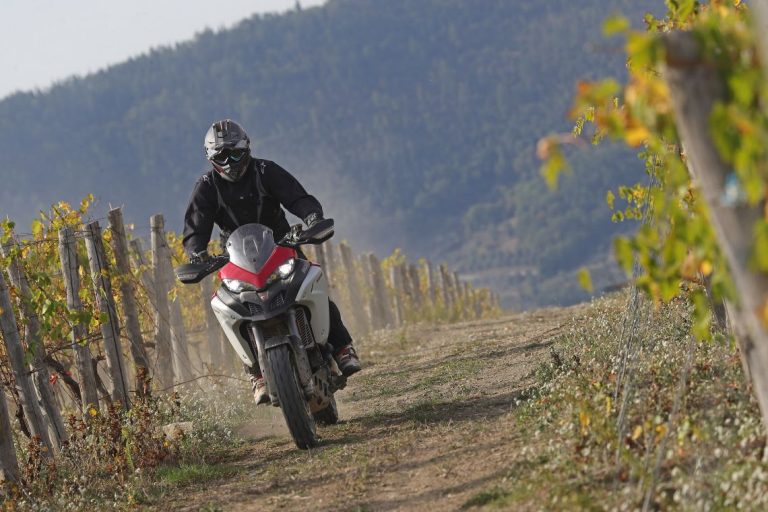Ducati has totally redesigned its Multistrada Enduro to make it more user friendly. But has the company succeeded? Julian Challis heads to Tuscany to find out
This could easily become very addictive. Despite the ever-sensible part of my brain telling me it’s not a good idea, the feeling of blasting a 158-horsepower bike down a dirt track in the autumn sunshine is just too much of a hit to resist.
The back wheel kicks out beautifully as I take a sweeping corner, the massive tyre sends an avalanche of rocks into the trees as the Ducati surges forward towards the rolling vineyards on the horizon. This is one of those rides that you don’t ever want to end.
OK, so let’s give this bucolic scene some context. The bike I’m riding is the all-new Ducati 1260 Multistrada Enduro, and the location for this off-road adventure is the stunning landscape of Tuscany, a couple of hours from Ducati’s factory in Bologna.
It’s hard to imagine a better setting to launch the new bike, and the Italians have pulled out all the stops to ensure the new bike has been given a setting in which it can shine.
And that’s probably a wise idea because the outgoing Multistrada 1200 Enduro had a number of shortcomings that needed addressing. A shortcoming that had arguably meant the bike hadn’t sold in the numbers that Ducati had expected or indeed hoped for.
While technically brilliant, as you might have expected from the brand given their massive presence in road racing from WSB to Moto GP, the 1200 was physically a very tall and imposing bike. If you were even a smidge under 6ft, riding the Ducati was pretty intimidating and moving it around from stationary was positively worrying.
The height and bulk of the machine was masking its true ability, and the powerful engine wasn’t helping the situation. Add in a dashboard that was far from intuitive to navigate and it was clear that a major rethink was necessary. And that’s exactly what the engineers have done, casting their attention over every part of the Enduro.
The new 1260 may look very much like the 1200 but, as just about everything from the chassis to the engine have been altered, changed, replaced or upgraded, there is definitely a touch of ‘Trigger’s Broom’ about the new machine.
While sticking to the brand’s core values of style, sophistication and performance, the changes to the Multistrada Enduro had very clear aims in mind – to make it more enjoyable to ride, more accessible to riders and more intuitive to use – all pretty good things to aim for really. So, what exactly has changed?
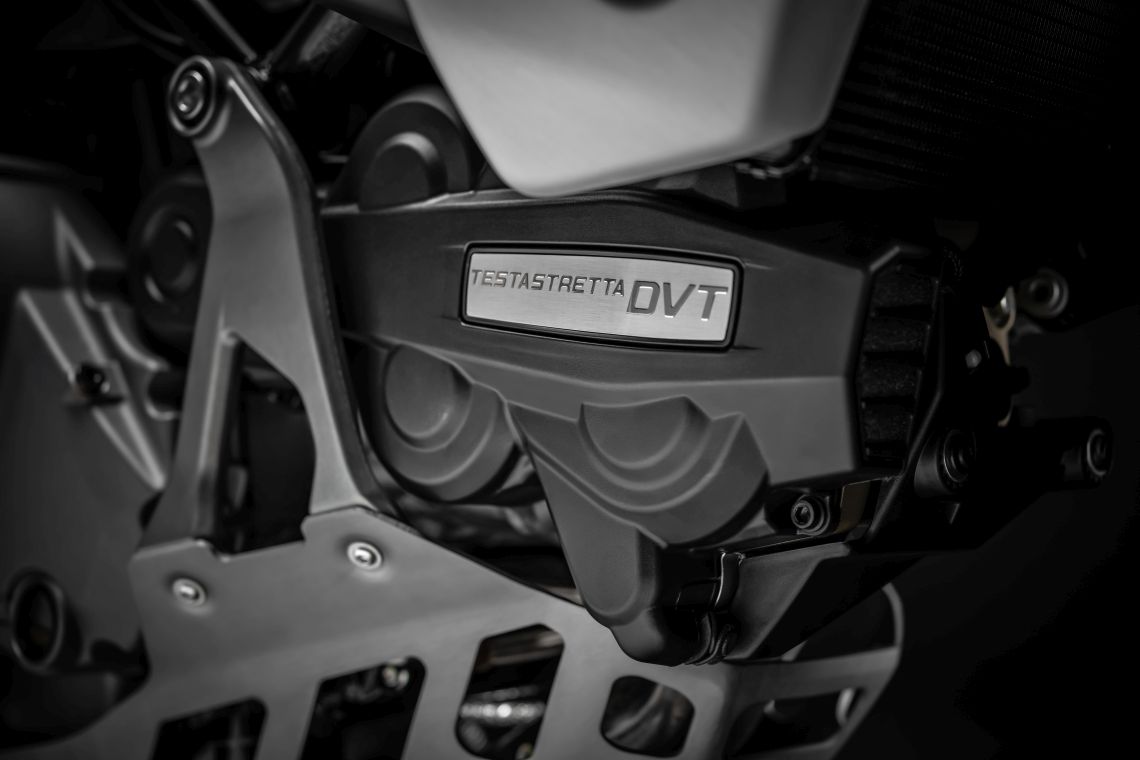
Well, first off, the 1200 lump has been ditched in favour of the latest incarnation of the iconic Testastretta engine, the DVT 1262, first seen in the company’s street bike, the Diavel. The motor has Desmodromic variable valve timing and is proven to give strong low-end torque and power through the rev range, giving the new 1260 that impressive 158bhp at 9500rpm, and a torque figure of 128 Nm at 7500rpm.
The tractability of the new motor also allows the higher gear selection and, to match this, Ducati has shortened the gear ratios too. Oh, and the company has fitted the slimmest and best-looking end can you are ever likely to see!
But don’t think all this focus on performance has led to a maintenance-heavy, needy motor. Far from it, as the 1260 now has a 9,000-mile service interval and a staggering 18,000 miles before the valve service needs to be done.
There’s a very real chance that many of these bikes may take a decade to reach anything like that figure. On the chassis side of things, Ducati has gone on an all-out assault to get the 1260 to be lower, easier to move about when loaded and generally nicer to live with.
The seat height is down by 10mm to 860mm – there is a further low seat option at 840mm or high version at 880mm – with the footpegs being dropped by the same 10mm. The bars are down 30mm and the suspension travel at both ends is reduced by 15mm to 185mm.
To add to the mix, Ducati has also gone for some weight saving too, with a lightened, thinner swingarm and new tubeless spoked wheels that continue the diet theme.
But while most of the weight figures seem to be coming down, the new 1260 has an increased payload of 230kg, some 20kg up on the previous model, though quite how you can measure the weight of your fully-loaded Ducati with you and your passenger sat on without your own personal weighbridge is not clear…
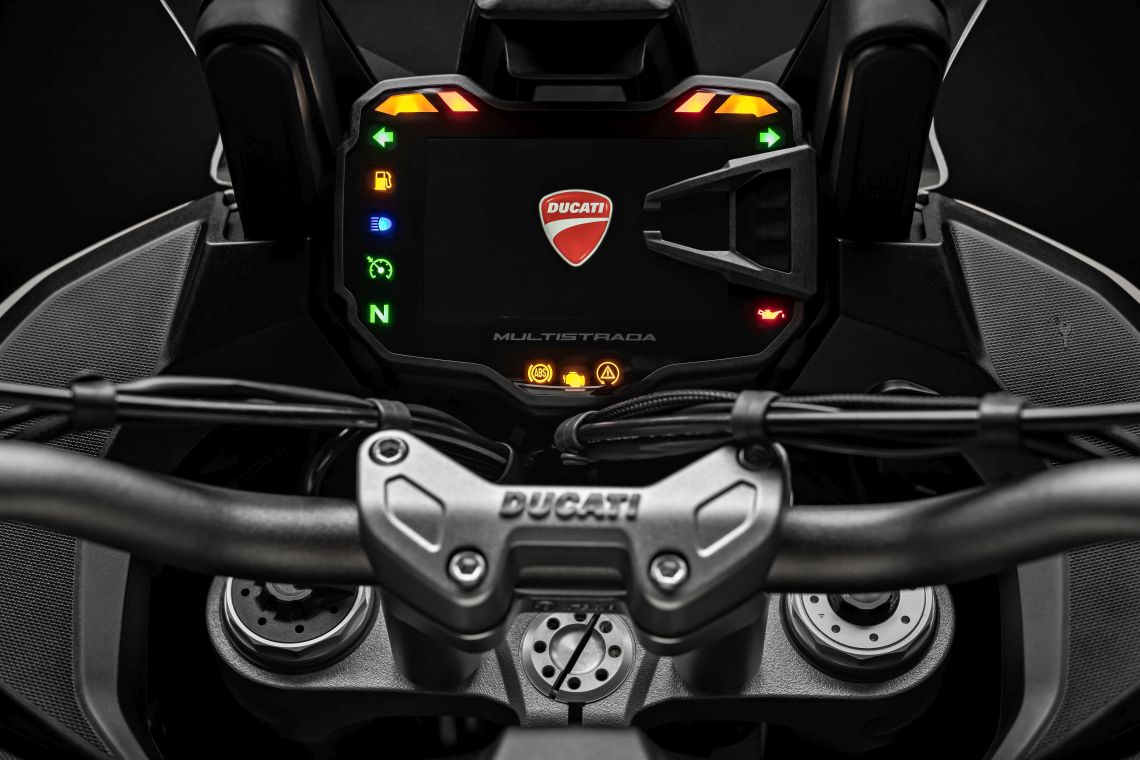
With so many changes still to assess, it was good to be taking the bikes out on the road first as any hope of scrolling through options on the new 5” TFT screen while bouncing the 1260 through the vineyards was perhaps unrealistic.
For the tarmac element of the test, Ducati had lined up a fleet of identical 1260s, decked out in the sand colour. I say ‘colour’, but this finish is both sand coloured and indeed textured like somebody at the factory has passed a sheet of sandpaper through the office laminator and liked the effect.
Personally, I was not a fan of either the look or feel of the paint finish, reminding me of some Tupperware my mother used to have in the 70s. Faced with this or the cheaper Ducati red, there is no contest.
The test bikes were kitted out with a set of the optional Touratech panniers, 40 litres on the right and 45 on the left, reflecting the fact that many of the bike’s owners will fit their new 1260s with luggage.
Astride the Ducati, the description of sitting ‘in the bike’ rather than ‘on’ that we’d been told about in the press briefing, was particularly accurate, with the large tank swooping up in front of you towards the wide bars and then down to the trademark Multistrada nostrils of the bike’s front beak.
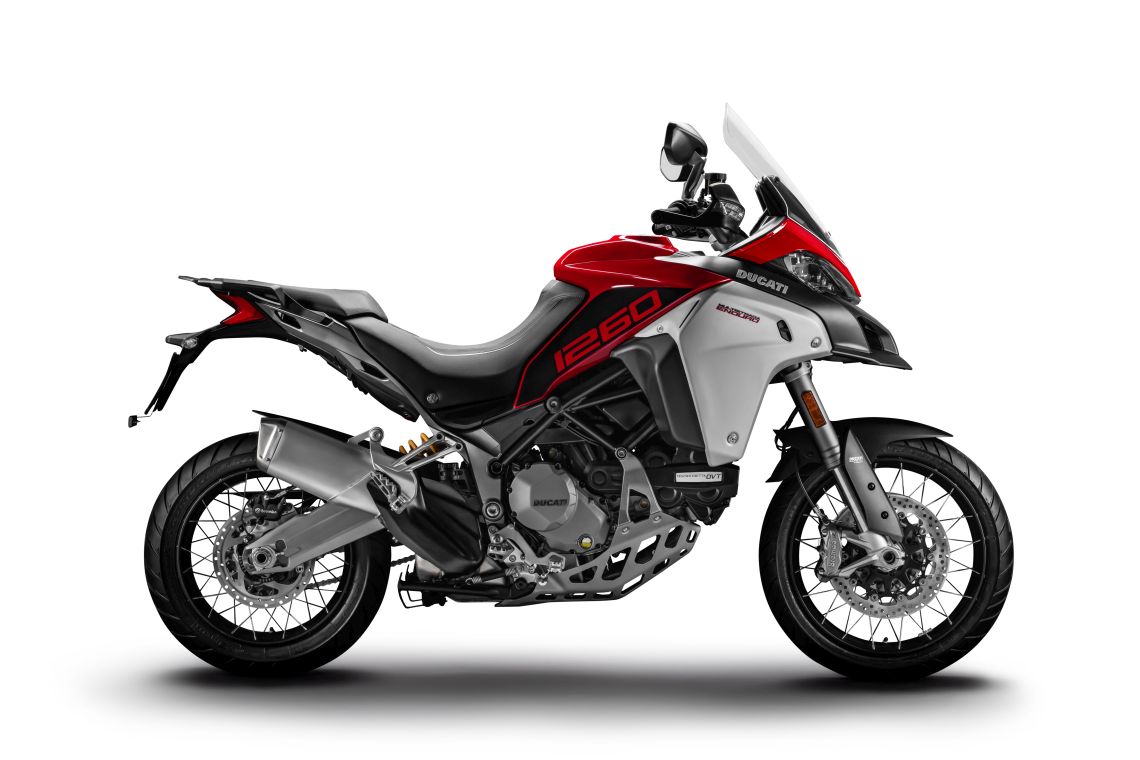
While I can see this low position helps the dimensions and manoeuvrability of the bike, it does enforce the physical size of the bike as you look toward the screen. Turning to the TFT dashboard, Ducati has worked on the interface between the rider and the information screen with a new operating system and a simpler way to swap between the various options.
And what has been done is good, with clear navigation between the menus and easy selection of the required set up.
The Ducati uses electronically adjustable suspension as standard at both ends – the wonderfully named Ducati Skyhook Suspension – so I selected a moderate setting for the road ride, backing this up with the similarly mellow ‘touring’ riding mode for the first part of the ride. With nearly 160 bhp on tap and 250kg of brand new Italian metal beneath me, I certainly wasn’t going to risk full banzai mode now, or maybe even ever.
After leaving the winding drive away from the castle and on to the similarly winding roads, the Ducati felt instantly likeable. With the electronics making sure things didn’t get out of hand, I enjoyed both the power and the handling of the big 1260 as we swept through the achingly beautiful landscape. I experimented with the quick-shifter (DQS) on a few straighter sections of tarmac – of which there were precious few!
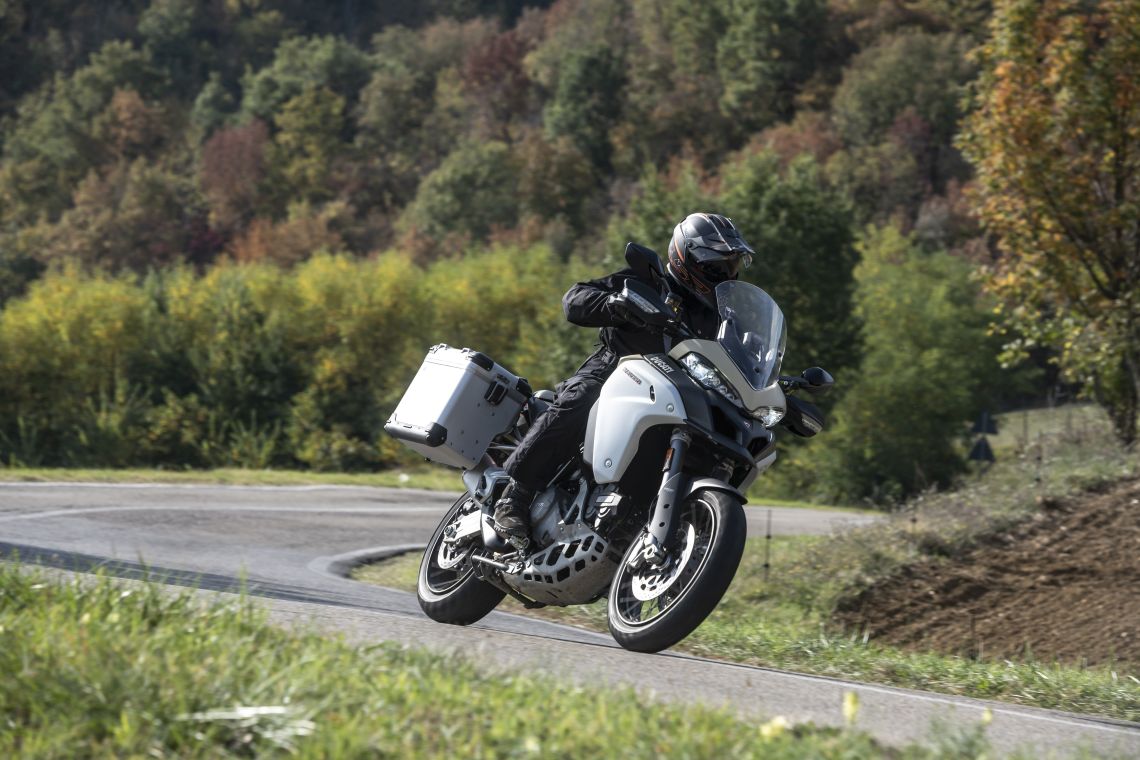
If you’ve not used one before, it takes a bit of mind resetting to get used to nailing the throttle and just snicking up through the gears without either throttling off or touching the clutch. But once you’ve got there, it’s a really enjoyable bit of tech to have in place, bringing a massive grin every time. Moto GP cool and no aching clutch hand in one fell swoop.
The roads have more than their fair share of hairpins and we dropped down and then climbed again through sun-dappled woodland and tiny villages. The massive 320mm front discs and WSB derived Brembo pots haul up the bike whenever required, the three-level Bosch Cornering ABS ready to step in, in case things get squirrely.
Ducati’s work on the chassis has paid off and the bike feels planted and secure, but as the speeds increase it does become evident that this bike is designed with off-piste adventures in mind, and no matter what the suspension trickery, a bike with this much mass and 185mm of available travel at both ends needs to be treated with a bit of respect.
There are apparently 400 different combinations available on the suspension alone, between on and off-road, one passenger, two passengers, luggage or no luggage to preload settings and damping options, so it might take you a while to reach the optimum setting for the ride you are on.
I settle for trying out a few different options every time we stop, each offering a slight change from the previous choice.
The 1260 also has other control modes to choose from, from traction control to wheelie control, although I’d be lying to say that in the course of the test ride I was ever in danger of backing the bike into fast corners or hooking up such an impressive wheelie that I wanted the bike’s IMU computer to get the wheel back down.
Nice to have the options though, and the large display makes the process of altering the various parameters easy.
Ducati’s 5” TFT screen is maybe not as sophisticated as it could be, with a line of more conventional ‘Idiot lights’ on either side, and a plastic overlay which draws attention to the gear selected.
All of these work just fine, it just feels like the designers could have gone the extra mile and incorporated all these elements into the software of the display.
The screen also vibrates wildly at low revs if you are in a high gear which takes a bit of getting used to compared to in-line fours or indeed other twin-cylinder engines.
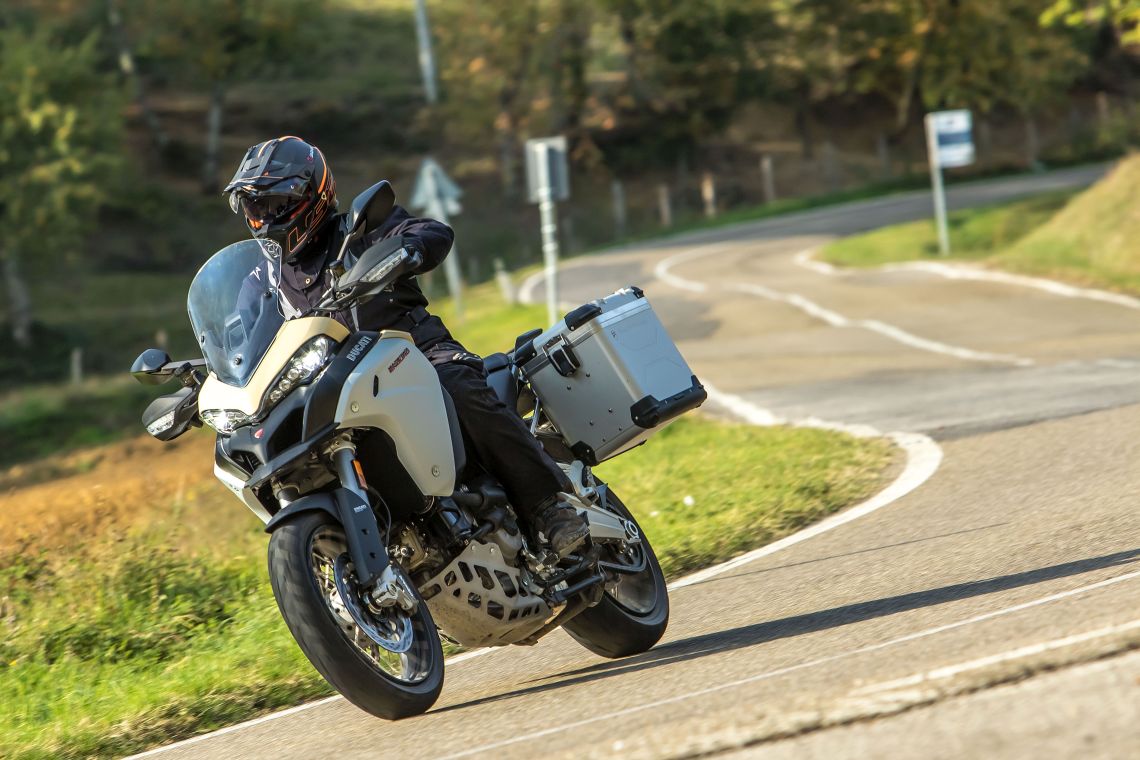
The Ducati has keyless ignition, but it still requires sliding the kill switch up before you can hit the start button which feels a little clunky. But these are small details on a technically wonderful and highly sophisticated machine and the road ride proves the 1260 to have moved on significantly from the outgoing 1200.
But to truly meet Ducati’s intentions with this machine, it’s the off-road performance that needs to impress – this is the Enduro version of the Multistrada after all…
Ditching the beige bike, the off-road duties were passed over to the far more pleasing blood-red version that sat sparkling in the afternoon sun. For this, Ducati had got things dialled for the occasion.
The Pirelli Scorpion Trail tyres had been replaced with the massively chunky Scorpion Rally hoops, the tall adjustable screen has been swapped for a shorty version that ducked almost entirely out of the way and thankfully, no hard luggage was to be seen.
Stripped to the basics and now in classic Ducati livery, the 1260 feels business-like and capable. I was going to enjoy this.
With the suspension set to one rider with luggage to increase the rear preload a tad, and with the engine locked into Enduro low power mode just to get the measure of things, it was onto the pegs and off into the vineyards. And straight away the 1260 makes sense.
The contours of the tank that felt a bit strange when sat down become instantly likeable as your knees settle into them allowing you to grip the bike effortlessly.
The bike’s wide footpegs are in the perfect position to allow full control of the machine with little input from the bars, avoiding the ‘death grip’ that can be so easy to use when piloting a big bike off-road.
The balance of the bike and the lowered centre of gravity make the Enduro incredibly agile on the trails, and changing direction is child’s play despite the near 250kg of weight beneath you. After getting used to the low power mode which had taken the power down to 100 bhp, it was time to up the ante by selecting the medium mode, but with the soft pick up.
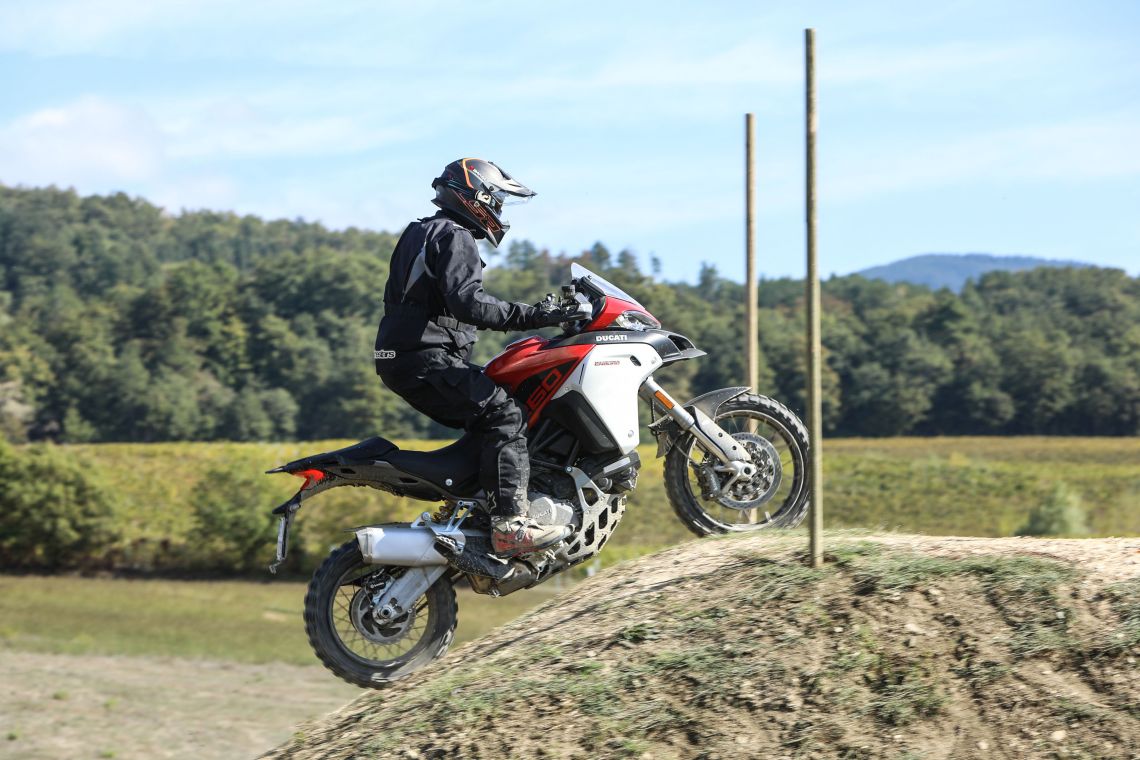
This delivers the full 158 bhp but with a sensible precaution to prevent heading towards the sky in a blur of red and black metal.
And jeez, is this thing powerful. Drop into the corner, ride the rut, straighten up and twist the throttle and the acceleration, even with the back wheel spinning and fighting for grip, is just insane.
But not in an unpleasant ‘this thing is going to hurt me’ kind of way – it’s in an entirely pleasant and intensely enjoyable way.
Our ride took us up into cool forests, where the sweeping trails were damp and slippery, and then dropped back down to the rocky lanes and tight turns of the leafy woodlands below.
The Ducati barely put a foot wrong and, although with no crash protection you do need to be aware of the bike’s momentum and weight when dropping downhill, the fantastic wall of power when you blast back up the other side makes it all worthwhile.
The Brembos perform excellently off-road too and having twisted round the clever end of the brake pedal to the higher off-road position, then scrubbing speed or dragging the rear wheel into corners is both easy and predictable.
For the final part of the afternoon’s test we headed for a large, open field which plays host to Ducati’s Off-Road Experience.
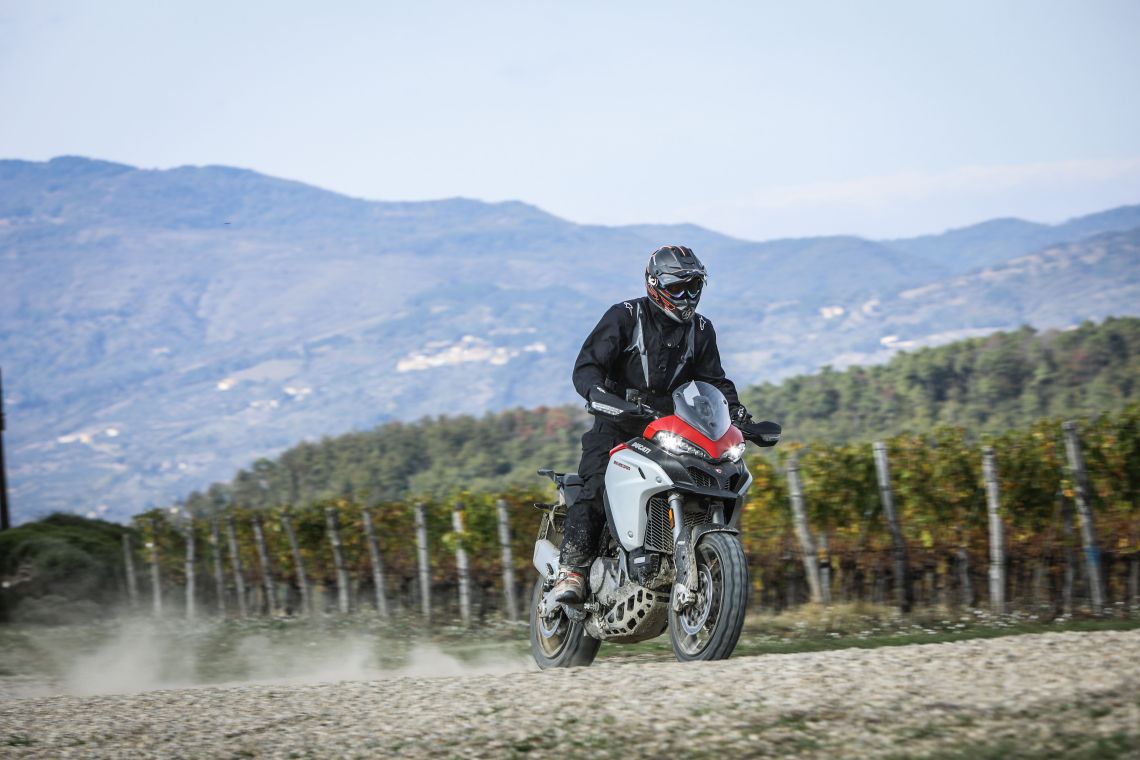
The instructors had laid out a variety of obstacles to test both the bike and the riders that attend the school, and so we get to test the 1260 Enduro in the same course.
The first part was a sinuous track mown into the long grass that snaked its way across half of the field, so I decided to treat it as a huge trials section and stay up on the pegs for the entire length of the track.
Now, this shouldn’t be a plan that instantly falls to mind on a big capacity adventure bike, but the 1260 had shown such easy and effortless balance that I’d no hesitation, and that confidence paid off with a clean pass every time.
The bike holds its line on off-cambers with the poise of a much lighter machine, and although the engine is madly powerful, it’s delicate enough to trickle around the tightest of bends without issue.
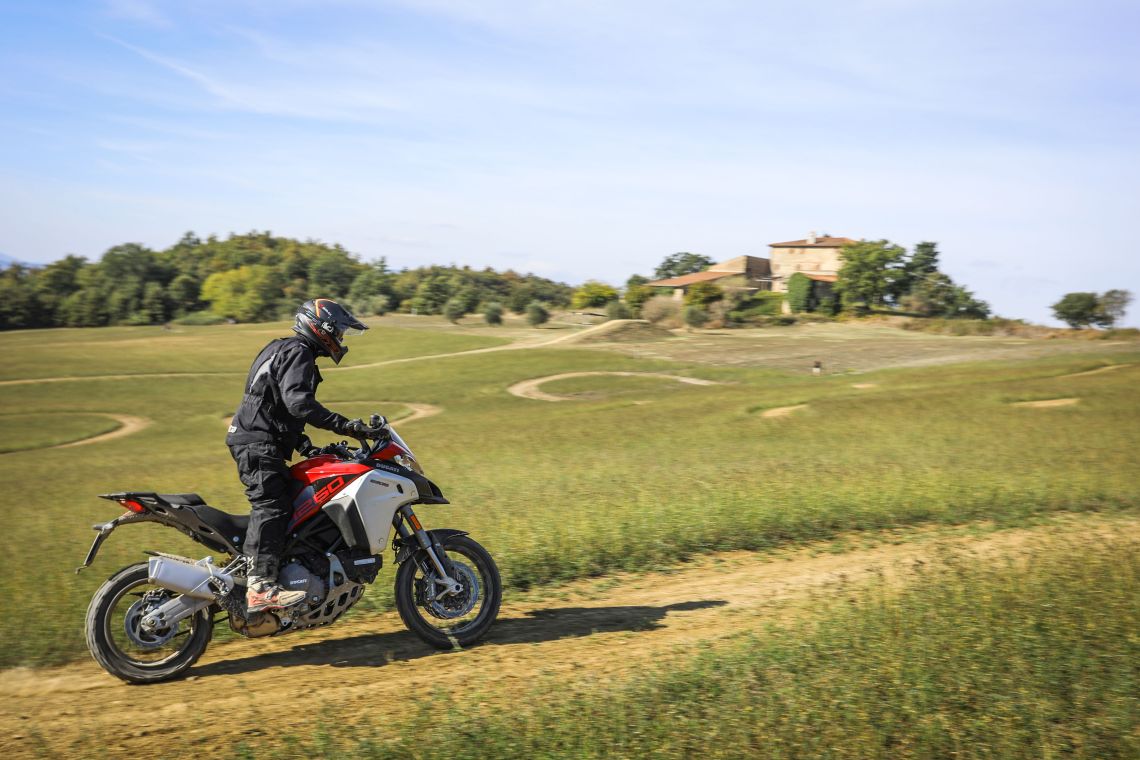
Price: From £17,755
Engine: Ducati Testastretta 1262 liquid-cooled, L Twin 2-cylinder, four-stroke engine
Displacement: 1262cc
Maximum Power: 158bhp @ 9,500rpm
Suspension: Front; 48mm fully-adjustable USD forks, electronic compression and rebound adjustment with Evo Ducati Skyhook Suspension. Rear; Fully-adjustable Ducati monoshock with electronic compression and rebound adjustment with Evo Ducati Skyhook suspension.
Brakes: Front; Twin 320mm semi-floating discs with radially mounted Brembo M4 32-piston calipers.
ABS: Bosch cornering ABS
Tyres: Front; 120/70 ZR19. Rear; 170/60 ZR17. Pirelli Scorpion Trail II or homologated for Pirelli Scorpion Rally
Weight: 254kg
Tank Capacity: 30l
Seat Height: 860mm
Colours: Red, Sand
The second part entailed essentially belting up and down hills on the bike and then moving onto a series of obstacles from a series of logs to uphill steps and slaloms, but by the time I hit them I was slinging the Ducati around like my trusty KTM EXC 250 back home.
And that’s a pretty big compliment for a very big bike – if you bought one of these bikes and never took it off-road, you’d be missing an incredible and life-affirming experience.
So, has Ducati hit the brief? Has the manufacturer managed to turn the tall and unruly teenager into a mature and capable adult? Well on the basis of my time spent with the 1260 I’d have to say a resounding yes – the new Multistrada Enduro is more refined, better designed and easier to use than the 1200 on just about every level.
But thankfully, while producing the new Multistrada Enduro, Ducati has also managed to keep enough of the previous bike’s intoxicating power and undeniable presence that there’s still some of that teenager left. This bike rocks.
ABR Verdict
As a commuter
While the 1260 would make a passable commuter, to subject nearly £20,000 of finely crafted Italian engineering to the daily grind would seem to be a cruel sentence indeed. There are better commuters than the Ducati.
As a weekend tourer
Touring on the Multistrada Enduro would work well, although if that’s all you intended to do with the Ducati, you might be better choosing the standard Multistrada 1260 which has better onroad prowess.
As an off-roader
Now you are talking. The Multistrada 1260 Enduro eats off-road for breakfast and spits out the stones like bullets from a Bren gun. Yes, it’s a big unit, but the superb balance and great ergos make it feel perfectly at home when the going gets rough. And that power? Totally addictive.
As a continental road tourer
If road touring is your thing, then the Ducati will look cool doing it. There are enough suspension settings to fine-tune things to your luggage and whether your riding two-up or solo, but with the longer travel suspension and higher stance compared to the standard Multistrada, it’s worth considering whether the Enduro is the best option.
As an RTW Overlander
The Ducati would indeed make a great RTW bike as it has everything you’d need to destroy big distances at the twist of your wrist, even if practical considerations like parts availability and how difficult it might be to pick up in soft sand might enter the equation.
As a pillion carrier
Pillions will enjoy the high position at the rear of the 1260 Enduro, even if the seat is not quite in the Parker Knoll comfort level. There’s some nice handles back there – what more could you want?

